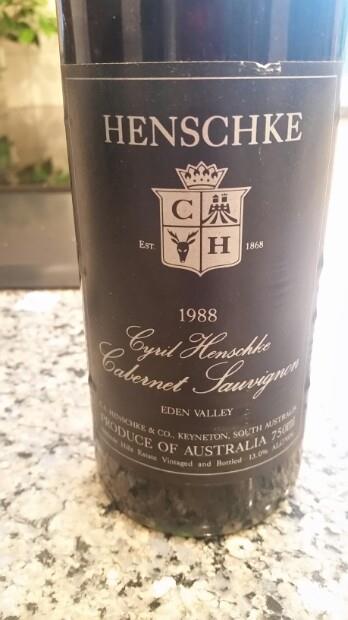
External search
Google (images)
Wine Advocate
Wine Spectator
Burghound
Wine-Searcher
Vintages
2010
2005
2004
2003
2002
2001
2000
1999
1998
1997
1996
1995
1994
1993
1992
1991
1990
1988
1987
1984
Show more
From this producer
Show all wines
All tasting notes
|
| Drinking Windows and Values |
| Drinking window: Drink between 1995 and 2008 (based on 4 user opinions) |
| Community Tasting History |
| Henschke Producer website
FIRST GENERATION – 1803-1873
Johann Christian Henschke
Johann Christian Henschke, born on December 24, 1803, departed from Kutschlau in the province of Brandenburg in the summer of 1841, and after an ill-fated 98-day voyage aboard the Skjold, arrived in South Australia on October 27. His wife Appolonia Wilhelmine, and six-year-old son Johann Friedrich Wilhelm died during the voyage and were buried at sea; nine-month-old daughter Johanne Luise died while they were awaiting departure from Hamburg. Johann Christian’s brother, Johann Martin, and his family also made the journey aboard the Skjold, while their other brother, Johann Georg, and his family followed on the August in 1856.
Upon arrival, with his two surviving children (Johann Gottlieb and Johann August), Johann Christian stayed briefly at Klemzig and Hahndorf, before settling for a time at Lobethal in the Adelaide Hills, where in 1843 he married Dorothea Elisabeth Schmidt, with whom he was to have eight more children. In 1847, after Johann Christian and many of the other Lobethal founders became naturalised and eligible to purchase land, he and his family” settled at Krondorf village near Bethany in the Barossa Valley, where the house and outbuildings still stand today.
In 1862 he purchased land in the North Rhine district (later renamed Keyneton) of the Barossa Range, so named because it was thought the area was capable of producing good quality wine. Initially travelling by foot from Krondorf to North Rhine, he started to develop his property by adopting the traditional self-sufficient farming methods of his homeland, and with the help of his son Paul Gotthard, planted a small vineyard. A farmer and mason by trade, Johann Christian built a small two-storey cellar into the side of the hill for the first vintages of riesling and shiraz, with the first sales in 1868.
THE FIFTH GENERATION
Being mindful of their role as custodians
Stephen and Prue continue to craft their white wines with a focus on purity, while their red wines have a strong focus on terroir, using traditional winemaking techniques.
“Prue and I are the current ‘keepers of the flame’. Just as earlier generations have done, we want to manage the vineyards and winery so they can be passed on to the next generation in better condition than we inherited them. The last 50 years have been an incredible journey for the Australian wine industry. Hill of Grace and Mount Edelstone are arguably the two oldest single vineyard wines produced in this country that tell the wine story of Australia. Our vision would not be complete without the expectation that future generations will uphold and perpetuate our belief that such ancient and unique single-vineyard sites can produce exceptional wines that are prized for their beauty and rarity.”
– Stephen Henschke
Cabernet SauvignonCabernet Sauvignon is probably the most famous red wine grape variety on Earth. It is rivaled in this regard only by its Bordeaux stablemate Merlot, and its opposite number in Burgundy, Pinot Noir. From its origins in Bordeaux, Cabernet has successfully spread to almost every winegrowing country in the world. It is now the key grape variety in many first-rate New World wine regions, most notably Napa Valley, Coonawarra and Maipo Valley. Wherever they come from, Cabernet Sauvignon wines always seem to demonstrate a handful of common character traits: deep color, good tannin structure, moderate acidity and aromas of blackcurrant, tomato leaf, dark spices and cedarwood.
Used as frequently in blends as in varietal wines, Cabernet Sauvignon has a large number of common blending partners. Apart from the obvious Merlot and Cabernet Franc, the most prevalent of these are Malbec, Petit Verdot and Carmenere (the ingredients of a classic Bordeaux Blend), Shiraz (in Australia's favorite blend) and in Spain and South America, a Cabernet – Tempranillo blend is now commonplace. Even the bold Tannat-based wines of Madiran are now generally softened with Cabernet SauvignonMuseum ReserveYalumba uses the "Museum Reserve" designation on it's entire line of fortified wines. You need to look at the labels closely (check the UPC if in doubt) to see if it is the Tawny or Muscat, and if the Tawny, is it the "21 Years Old Antique Tawny", the "50 Year Antique Tawny" or the just plain "Antique Tawny"Australia Wine Australia (Australian Wine and Brandy Corporation) | Australian Wines (Wikipedia)South Australia South Australian Wine Industry Association | South Australian Wines (Wikipedia)Barossa Barossa Wine (South Australian Tourism Commission) |
|




